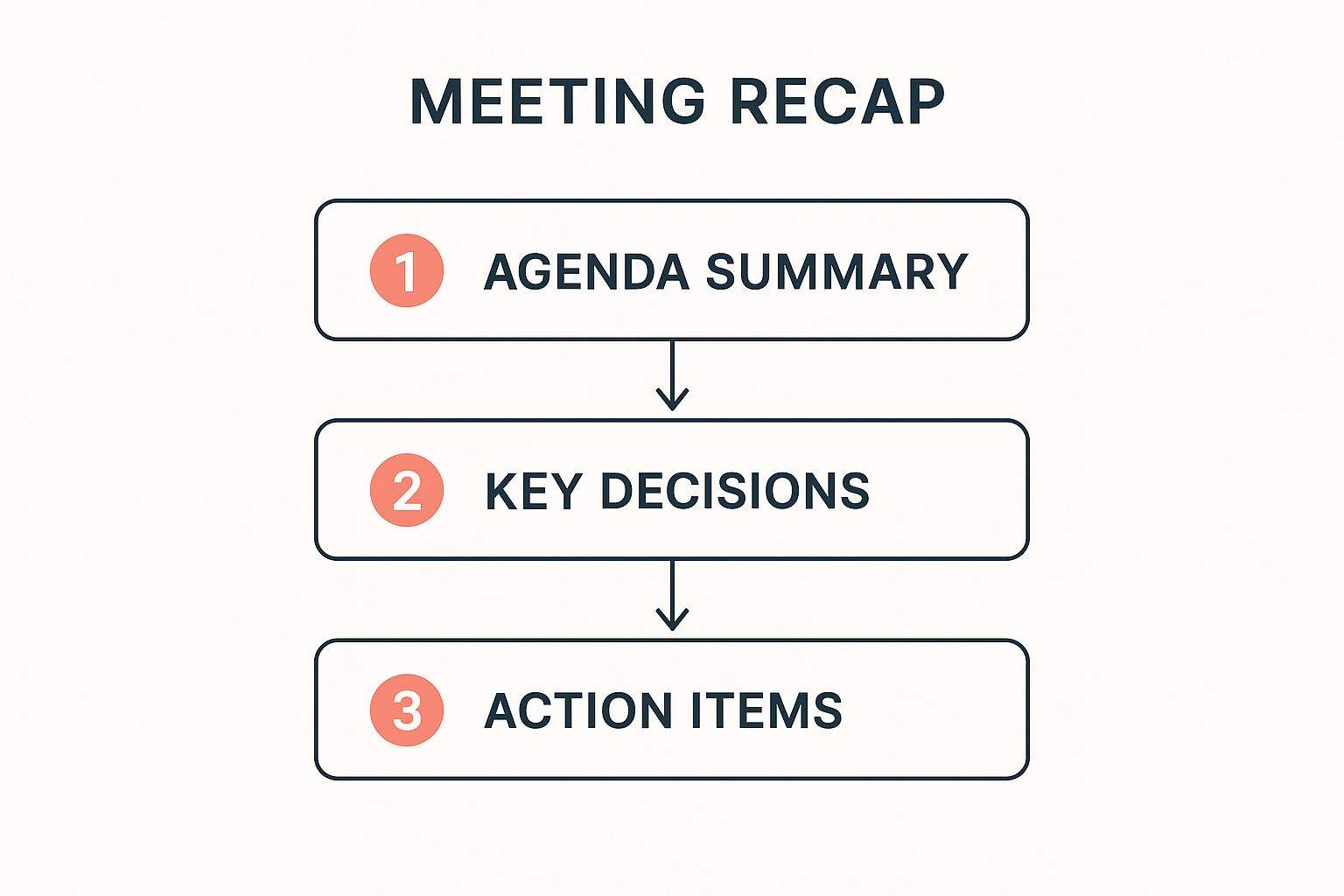A good meeting recap format is more than just a list of notes. It's structured, actionable, and—most importantly—sent out quickly. For agencies, this is what keeps client projects aligned and holds everyone accountable by clearly defining decisions, assigning action items with deadlines, and laying out the next steps for the whole team.
Why Your Agency's Current Meeting Recaps Are Failing

Let's be honest. For most agencies, the meeting recap is a neglected afterthought. It might show up a day or two late as a vague email, cobbled together from memory. This is exactly where client projects start to go off the rails.
When recaps lack structure, they just can't capture the real essence of a conversation. Important details get lost, key decisions are buried, and action items become fuzzy suggestions. This is a fast track to missed deadlines, confused clients, and a frustrated team where everyone walks away with a completely different understanding of what just happened.
The Real Cost of Vague Recaps for Agencies
The fallout from a bad meeting recap goes way beyond a simple miscommunication. For an agency, these seemingly small slip-ups can have a serious financial and reputational impact. Every ambiguous note plants the seed for a potential risk that can easily snowball into a major project crisis.
Here are a few of the all-too-common problems I've seen stem directly from ineffective recaps:
- Scope Creep: A note like, "Discussed adding new social media graphics," is a classic. Without a documented decision and a clear "why," the client might assume it's happening, while your team thinks it was just an idea. Just like that, unbilled work worms its way into your pipeline.
- Eroding Client Trust: When clients have to keep asking, "What was decided about the Q3 budget?" or "Who's handling the landing page copy?" it sends a clear signal: you're disorganized. Consistent, clear communication builds confidence. Inconsistent follow-ups just plant seeds of doubt.
- Lost Momentum: A great meeting creates a ton of energy and forward motion. A delayed or unclear recap kills it instantly. When your team has to wait around for clarification on what they're supposed to be doing, you lose valuable hours—or even days—stalling the project's progress.
The core problem is that a meeting isn’t truly over until the recap is sent. It’s the final, crucial step that transforms a conversation into a concrete plan. Without it, you're just leaving success up to chance.
Why Hybrid Work Demands a Better System for Agencies
The shift to hybrid and remote work has only made these challenges more intense. With team members and clients scattered across different locations, you can no longer count on a quick hallway chat to clear up confusion. Your written communication has to be exceptionally clear and serve as the single source of truth.
The data backs this up, showing massive gaps in how effective meetings really are. One study found that a staggering 64% of recurring meetings don't even have a formal agenda, which is the absolute baseline for any decent recap. Vague notes just don't cut it. You can explore the full research on meeting effectiveness here. This lack of structure is precisely why a standardized meeting recap format is no longer a "nice-to-have"—it's an absolute necessity for any modern agency.
The Anatomy of a High-Impact Agency Recap Format
A truly effective meeting recap isn't just a brain dump of notes; it’s a strategic framework built to turn conversations into tangible action. I've seen firsthand that top agencies don't leave this to chance. They use a consistent structure to kill ambiguity and get everyone—from the internal team to the client—on the exact same page.
Forget those generic templates that barely scratch the surface. A high-impact recap is built on specific parts that answer the big questions: What did we decide? Why did we decide it? Who's doing what, and by when? Getting this right is often the difference between a project that stalls and one that picks up serious momentum.
The infographic below shows the core flow, starting with the big picture and drilling down to the nitty-gritty of getting things done.

This visual breaks down the logical path, from reviewing the agenda to locking in decisions and assigning clear, actionable tasks. If you adopt this flow, every recap you send will tell the full story, from discussion to delegation.
To make this super clear, here’s a breakdown of the critical sections every agency meeting recap should include. Getting these components right is the key to ensuring total clarity and accountability.
Key Components of an Effective Agency Meeting Recap
This table serves as a simple checklist. If your recap has all these elements, you're setting your projects up for success and minimizing the chance of miscommunication down the road.
Section 1: Document Key Decisions and Their Rationale
This is, without a doubt, the most important part of any agency recap format, but it's also where most people drop the ball. Just stating a decision isn't enough. You have to capture the why behind it to give it context and stop the team from rehashing the same debate a week later.
Instead of a vague note like, “Approved new landing page design,” a powerful recap gets specific.
For example:
- Decision: Approved landing page mockup V3.
- Rationale: The team agreed V3’s streamlined navigation and stronger call-to-action align better with the Q3 conversion goals we discussed in the kickoff. This version also tested best with our internal user panel for clarity.
Documenting the rationale reinforces the strategic thinking behind the choice, which is incredibly valuable for clients and stakeholders who weren't in the room. It also becomes a critical reference point a month from now when someone inevitably asks, "Hey, why did we go with that option again?"
Section 2: Assign Action Items with Owners and Deadlines
Ambiguity is the absolute enemy of progress. An action item without a clear owner and a firm deadline is just a wish—one that will almost certainly be forgotten. This section of your recap needs to be ruthlessly specific to drive accountability, both internally and with clients.
Every single action item should follow a simple, non-negotiable formula:
- The Task: A clear, concise description of what needs to be done.
- The Owner: The single individual responsible for seeing it through.
- The Deadline: The specific date the task is due.
Vague tasks lead to vague outcomes. Assigning ownership transforms a hopeful wish list into a concrete project plan, ensuring that every deliverable has a clear champion responsible for moving it forward.
This level of clarity leaves zero room for interpretation. It also makes project tracking a breeze because you can copy these items directly into your PM tool like Asana or Monday.com. Getting these details down starts with how you take notes in the first place. For more on that, check out our guide on how to take better meeting notes to make sure you never miss a thing.
Section 3: Clarify Next Steps and Identify Blockers
Finally, a great recap always looks ahead. The "Next Steps" section outlines what’s happening next and when, which helps manage expectations for future meetings or communications. It might detail the agenda for the next check-in or confirm when a follow-up report is coming.
Just as important is the "Blockers" section. This is where you call out anything standing in the way of progress. Identifying and documenting these obstacles is the first step toward knocking them down.
Agency Example:
- Next Steps: The creative team will present the revised campaign concepts at our weekly sync next Tuesday.
- Blockers: We are currently blocked on the social media ad budget until we receive final approval from the client's finance department. [Owner: Client PM] is following up.
This kind of transparency makes sure everyone is aware of dependencies and potential delays, allowing the team to tackle issues proactively before they derail the entire project.
How to Adapt Your Recap for Any Type of Agency Meeting

Let's be honest: a rigid, one-size-fits-all meeting recap is a waste of everyone's time. In the agency world, the summary you send after a high-stakes client kickoff serves a completely different purpose than the notes from a rapid-fire internal creative review.
The secret is to treat your recap like any other deliverable. It needs a clear audience and a specific objective. For clients, you're building confidence and confirming alignment. For your internal team, you're all about driving action and clarifying who owns what. If your template can't do both, it's broken.
Tailoring Recaps for Critical Client-Facing Meetings
When you're talking to clients, your recap is much more than just meeting notes. It's a critical tool for managing expectations, reinforcing your agency's value, and creating a paper trail. The tone has to be professional, and the content must prioritize absolute clarity. Any misunderstanding here can quickly spiral into scope creep or a strained relationship.
For these meetings, your recap should lean heavily on:
- Key Decisions and Shared Understanding: It's crucial to frame decisions as collaborative agreements. Swap out "We decided to..." for language like, "We all agreed that the best path forward is..." This small shift reinforces the feeling of partnership.
- Client Action Items: Clearly and politely outline what you need from their side. Get specific. Instead of a vague "send assets," try "Please provide the hi-res brand logos and style guide by EOD Wednesday." It also helps to gently mention the impact of any potential delays.
- Project Milestones: Always reiterate the important dates and upcoming deliverables. This keeps the project timeline front and center for everyone involved.
Think of your client-facing recap as a "confirmation of services" document. It protects your agency by creating a clear, agreed-upon record of what was decided, what’s next, and who’s on the hook for each piece of the puzzle.
Fine-Tuning Recaps for Fast-Paced Internal Huddles
Internal recaps are all about two things: momentum and accountability. You can drop the formal language and get straight to the point. These aren't meant to impress anyone; they're working documents designed to propel the team forward. Efficiency is the name of the game.
The entire goal is to translate conversation into concrete, actionable tasks. A simple shift in focus makes all the difference.
Here’s how that looks in practice:
- For a Creative Review: The recap needs specific, actionable feedback. "Client wants a bolder design" is useless. Instead, write: "Update hero image with Option B; change CTA button color to #FF5733." There’s zero room for misinterpretation there.
- For a Monthly Performance Check-in: This recap must be data-centric. Your summary should highlight key metrics, insights, and the resulting optimization tasks. For example: "Organic traffic is down 15% MoM. [Owner: SEO team] to investigate the drop in top landing pages and identify content gaps by Friday."
- For a Project Stand-up: A full, formal recap for a quick 15-minute sync is overkill. Often, a bulleted list in a dedicated Slack channel is perfect. Just focus on Blockers Resolved and New Action Items. This keeps the team moving without bogging them down in unnecessary admin work.
By adjusting the lens through which you write your recap, you transform it from a generic formality into a purpose-built tool. It becomes something that drives clarity with clients and, just as importantly, drives action within your team.
How Agencies Can Use Technology to Create Better Recaps Faster
In the agency world, speed is everything. But when you’re manually scribbling notes during a client call, you're already behind. Relying on handwritten notes or memory alone is a surefire way to let crucial details slip through the cracks between the meeting and your project management tool.
Frankly, technology offers a much smarter way to build your meeting recaps. Automating the grunt work frees your team up to actually participate in the conversation instead of just trying to capture it. This shift means your recaps aren't just faster—they're more accurate and directly plugged into your project tasks.
How to Build a Smart Recap Workflow for Your Agency
The real goal here is to create a seamless path from conversation to action. That journey starts with capturing every single detail accurately.
AI transcription tools are perfect for this first step. They create a complete, searchable record of the entire discussion so nothing gets lost in translation. We actually have a whole guide on how AI is changing the game for meeting notes, which you can check out here: the benefits of using AI for meeting minutes.
Once you have that transcript, the real magic begins. Instead of you manually pulling out highlights, smart tools can instantly identify key decisions and action items.
By bringing technology into your process, you turn the recap from a static document into an active driver of project momentum. It stops being about remembering what was said and starts being about making sure it gets done.
The next piece of the puzzle is getting those outputs to where your team actually works.
Why You Should Integrate Recaps with Your PM Software
A brilliant recap is useless if it's buried in an email inbox. The most effective agencies I've worked with have one thing in common: they connect their meeting notes directly to their project management software.
Imagine an action item from a client call automatically popping up as a task in Asana or Trello, already assigned to the right person. That’s what a smart workflow looks like.
This kind of direct integration kills manual data entry and finally closes the loop between discussion and execution. You can also push recaps into collaborative hubs like Notion, creating a living document that the whole team can comment on and update as the project evolves.
This efficiency is more important than ever. With meetings on the rise—projected to increase by 34% globally over the next five years, according to reports on Notta.ai—teams have to find ways to work smarter. To really get ahead, it's worth exploring the new wave of automated content tools, especially the key innovations in Generative AI that are completely changing how information gets summarized and shared.
Mastering Recap Timing and Distribution for Agency Success

You can write the most brilliant, actionable meeting recap in the world, but if it lands in everyone’s inbox a week late, its power just evaporates. A perfect meeting recap format is only half the battle; timely delivery is what turns a static document into a tool that actually keeps projects moving.
The momentum you build in a meeting is fragile. When you wait days to send a summary, details get fuzzy, enthusiasm dies down, and tiny misalignments can quietly grow into major problems. For high-performing agencies, the 24-hour rule isn't just a suggestion—it's non-negotiable.
The 24-Hour Rule: Why Prompt Delivery is Non-Negotiable
Sending your recap within 24 hours is the industry gold standard for one simple reason: memory. Everyone's recall is sharpest right after the conversation. This window gives attendees a chance to review and confirm the details while the context is still fresh, which dramatically cuts down on the risk of disputes later.
This urgency is even more critical when you consider how much time we all sink into meetings. Recent data shows employees spend around 11.3 hours per week in meetings, a number that's tripled since 2020. With nearly a third of the workweek spent in discussions, a prompt recap ensures that time translates directly into productive action.
Sending the recap quickly frames it as an active part of the project workflow, not just a passive archive of a past conversation. It signals to your clients and team that you prioritize clarity and are ready to act immediately.
Choosing the Right Distribution Channel and Audience
Who gets the recap is just as important as when. The distribution list should always include everyone who attended the meeting, but smart agencies know to think beyond the invite list.
- Key Stakeholders: Be sure to include any decision-makers who weren't in the room but need to stay in the loop, like a department head or the client’s executive sponsor.
- Project Team Members: Loop in anyone on the project team whose work will be affected by the decisions made, even if they weren't required to be there.
The channel you use for distribution matters, too. Exploring different content distribution strategies is just as vital for internal comms as it is for marketing. While email remains a reliable standard for formal client communication, other platforms can be way more effective for your internal team.
For instance, a recap sent in a dedicated project Slack channel or added as a comment on an Asana task keeps the information right where the work is happening. For more guidance, check out our ultimate guide on crafting effective after-meeting emails to clients to really perfect your approach.
Answering Your Agency's Toughest Questions About Recaps
Rolling out any new process in a fast-paced agency is bound to raise a few eyebrows. Shifting to a more structured meeting recap format is no exception, especially when old habits die hard. Let's tackle some of the real-world friction that comes up when you try to make this happen.
These aren't just hypothetical problems; they're the common hurdles I've seen teams stumble over. Here’s how to clear them.
How do we get busy clients to actually read the recap?
Let's be honest: no one wants to read a novel after a meeting, especially not a busy client. The key is to make your recaps impossible not to read because they are so scannable. Your format is everything here.
Use big, bold headings like "Key Decisions" and "Action Items" so a client can get the gist in five seconds flat.
Most importantly, don't just send a list of notes. Frame the recap as a tool for alignment. Kick it off with something like, "Just want to make sure we're perfectly aligned on next steps—here’s a quick summary of what we agreed on." Suddenly, it’s not just meeting notes; it’s a critical project document.
What if a client or team member disagrees with the recap?
This is exactly why you send the recap within 24 hours. Disagreements are a million times easier to sort out when the conversation is fresh in everyone's mind.
When you send it, don't position the recap as the final word from on high. Treat it like a collaborative draft.
A simple line changes the entire dynamic: "Please take a look and let us know by EOD tomorrow if this doesn't match your understanding." This little sentence turns the recap from a declaration into a handshake. It invites feedback, builds consensus, and stops small misunderstandings from snowballing into massive project delays.
Is a full recap necessary for a quick 15-minute internal check-in?
Absolutely not. Sending a formal, multi-section recap for a quick internal stand-up is overkill and will just annoy your team. But that doesn't mean you should skip documentation altogether. The idea is to maintain the habit of accountability, not create busywork.
For these quick syncs, just strip the format down to its bare essentials. A short, bulleted list in the relevant Slack channel is usually perfect. Just stick to the core questions:
- Decisions: What did we land on?
- Next Steps: Who’s doing what, and by when?
This lightweight approach keeps the momentum going and ensures every conversation, no matter how brief, leads to documented action. It reinforces accountability without bogging anyone down.
Ready to put this whole process on autopilot and give your agency a serious advantage? Scribbl is an AI meeting assistant that automatically transcribes, summarizes, and sends out your meeting recaps. It plugs right into your CRM and project management tools, turning conversations into action items without you lifting a finger.




